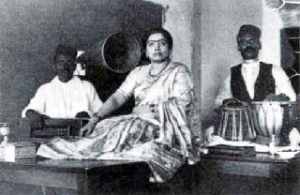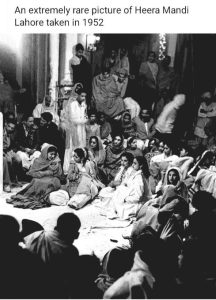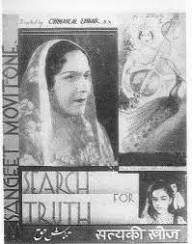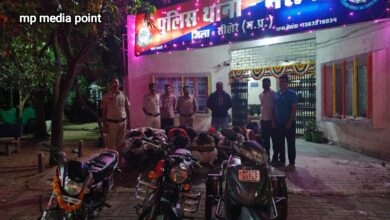
- वाकिफ नहीं हकीकत से इसलिए जुबां पर जुड़ा शब्द तवायफ है..वेस्टंडीज से डॉ अजय शर्मा
हिंदी-अंग्रेजी में मिलाजुला Iron
वेस्टंडीज,एमपी मीडिया पॉइंट
विशेष लेख
————-
वेस्टंडीज़ से डॉ अजय शर्मा (ajay sharma)
Heeramandi and the Tawaifs
Introduction

तवायफ़, एक अरबी शब्द है, जिसका प्रयोग मुगल काल मे निपुण गायिकाओं और नृत्यांगनाओं के लिए इस्तेमाल होता था। 19वीं शताब्दी से पहले यह कला और संस्कृति का मुख्य केंद्र हुआ करती थीं। कथक, दादरी और ठुमरी की विरासत तवायफ़ों से ही मिली है ।
इन तवायफ़ों के संरक्षक नवाब, राजा-महाराजा और कुलीन वर्ग के लोग हुआ करते थे ।

ये महिलाएं एक समय में अपनी कला, व्यवहार और स्वायत्तता के लिए जानी जाती थीं. ये क्लासिकल डांसर और सिंगर, शाही दरबारों में अपनी कला को प्रदर्शित करती थीं और राजपरिवारों का मनोरंजन करती थीं।

देश के सबसे अहम दौर में इन महिलाओं ने महत्वपूर्ण भूमिका निभाई थी। चाहे 1857 हो, या 1947…. आज़ादी की लड़ाई के दौर में इन महिलाओं ने स्वतंत्रता सेनानियों की पैसे से मदद की, उन्हे संरक्षण दिया और इसके साथ ही उनके लिए प्रेरणा बनीं.

कालांतर मे कई तवायफ़ो ने ग्रामोफोन रिकार्ड, थियेटर, भारतीय और पाकिस्तानी सिनेमा की नींव रखी ।
दुर्भाग्य से इन महिलाओं के सम्मान और शुचिता पर उठते सवालों की वजह से इनकी कहानियों, आवाज़ों और उपलब्धियों को कहीं पीछे धकेल दिया गया ।
कम जानकारी होने और आधे-अधूरे सच को तोड़-मरोड़कर पेश करने की वजह से आज तवायफ़ शब्द का इस्तेमाल अपशब्द के तौर पर और देह व्यापार में शामिल महिला के लिए किया जाता है ।

(खासतौर पर लेख़क ने हिंदी में इंट्रो और लेख में समावेश अंग्रेजी का इसलिये किया क्योंकि यह लेख दुनिया के करीब दो दर्जन मुल्कों में जाना है। …संपादक राजेश शर्मा)
गौहर जान, जद्दन बाई , हीरा मंडी और 1935 की फिल्म Talashe Haq का पोस्टर के चित्र संलग्न– राजेश शर्मा
Heera Mandi is a bazaar in the city of Lahore in Pakistan.
Before the 18th century, Heera Mandi was the center of culture, arts, and trade besides its association with the courtesans and performers who entertained the elite of society.
The history of Heera Mandi goes back to the 15th-16thth century. An area south of the Lahore Fort was developed as a residential neighborhood for attendants and servants of the royal court and the emperor. Since it was close to the fort, it was referred to as “Shahi Mohalla” or “Royal Neighbourhood”. The area became home to tawaifs and was visited by princes, and nobles
In 1799, Maharaja Ranjit Singh conquered Lahore. The locality was named after an officer, Hira Singh, who was the son of the prime minister of Maharaja Ranjit Singh. Hira Singh wanted to make the place an economic hub. While the courtesans stayed, he opened up a food grain market ( मंडी ) there, ‘Hira Singh Di Mandi’. The other two places that had grain markets were Multan and Talumba.
During the Mughal period, women mainly from Afghanistan and Uzbekistan were brought to Heera Mandi to entertain the royal court.
Dance, music, art, and aesthetics were central to the life of the courtesan. In fact, their mastery of these skills were a prerequisite for them to enter the trade. These women were trained in various arts, including literature, poetry, classical kathak, mujra, tarana, khayal, thumri, kajri, ghazal, and dadra, and became tawaifs upon mastering classical dance and singing.
The training of the young tawaifs will begin at a very early age, under the guidance and tutelage of Ustaads (masters). In addition, they cultivated the art of etiquette, good manners, decorum, and courtesy. The integral part of training was to learn to conduct themselves with grace and refinement. Most important was the knack for conversation, especially with the male clientele, which was to be studded with witticisms, repartees, and appropriate use of Urdu (and sometimes Persian) couplets The training of the courtesan included proficiency in the art of being coquettish. The aim was that the courtesan should be congenial and pleasing company.
Many well-known tawaifs practiced and learned music throughout their careers, seeking masters from different music traditions (gharanas) to add to their performance style. Most of them were well versed in classical music and could sing ‘dhrupad’, which is one of the toughest and richest forms of North Indian classical music, and needs a lot of practice. Tawaifs would compose poetry ( shayari), sing (ghazals), and dance with live musical composition.
Mujra :
The mujra in Awadh was a performance of dance and singing done by courtesans to entertain clients.
“Mujra dena” literally means to pay respects or to salute. When a courtesan sang at a mujra, the singing was accompanied by bhava, or gestures, eye movements, blandishments, and coquettishness. In mujras, the dancing went on for hours, and the best girls graced the occasion. The mujra programs of singing and dancing were always seasoned with wit and humor. The connoisseurs appreciated repartees and biting jests. The aim was titillation. The songs would charm and allure, and the sensual persona of the mujra dancer (or dancers) would fascinate the audience’s. This was despite the fact that the mujra dancer was fully clothed without any palpable display of body parts. The mujra was not wholly an erotic performance but was a choreographic salutation to the audience.
The courtesans, or ‘tawaifs’, of Heera Mandi were more than just entertainers. They played a pivotal role in the social and cultural life of the Mughal courts. Tawaifs were highly skilled, refined, and valued. They were financially independent and possessed agency over their lives and choices. They were influential among writers, journalists, and poets. The poets, in particular, longed for a tawaif to sing his poems. This was to ensure that his poetry is remembered and passed on generation to generations. “ *Shahi Mohallah* ” thrived under the patronage of Moghal rulers. Lahore was among the three power center’s under the Mughal rule, the other two being Delhi and Agra.
It was quite common for royal families to send their young nawabs to Heeramandi to learn adab, (अदब), tameez (तमीज़), and tahzeeb (तेहज़ीब), broadly translating to courtesy, manners, elegance, and etiquettes. They will also learn language (urdu) and write poetry, recognize, and appreciate good music.
British Colonial Rule
After the British colonization, things changed drastically.
The British, influenced by Victorian-era conservatism, made no distinction between cultured tawaifs (courtesans) and common prostitutes, dubbing both as fallen women. This, in turn, led to the elimination of the dance aspect from the livelihoods of the courtesans, confining them to sex work under a cloak of secrecy instead.
Under the British, Indian courtesans were left in a very precarious and insecure situation despite having once socialised with kings and courtiers, lived in opulence, protected culture, and dictated fashion trends.
Tawaifs and the Rebellion
The tawaifs had actively participated in anti-British actions behind the scenes. Their buildings, known as “kothas”, became meeting areas and hiding places for anti-British elements. Those tawaifs who accumulated wealth provided financial support to anti-British elements. Some tawaifs suffered retaliation from colonial authorities. Their kotha was searched, and their belongings were confiscated.
Along with societal power and influence courtesans of ancient India, wielded significant affluence. As accounted by Veena Talwar Oldenburg, they occupied the highest tax brackets in the civic tax ledgers of 1858–77 of Lukhnow. According to Oldenburg, British officials confiscated the property of the courtesans around that time for their involvement in the siege of Lukhnow and the rebellion against British rule in 1857. The lists of these properties include houses, orchards, and manufacturing and retail establishments for food and luxury items.
The Victorian era morality project of the British emphasized women chastity and domesticity. As public performers, tawaifs were equated with prostitutes and their kothas were branded as brothels.
European women were also seen around Indian seaports. However, it is also an embarrassing truth that one in every four European soldiers had a venereal disease.(Sexually transmitted diesease)
In those days, Tawaifs used to be the only source of popular music and dance and were often invited to perform on weddings and other occasions. With the emergence of new technology, their traditional space and modes of rehearsal came under serious attack.
Many tawaifs found space as performers in the newly emerging industries of mass entertainment, such as the Gramophone, theatre, and later films. The earliest singers to record for the gramophone, in the early 20th century, came from tawaif backgrounds, as did the first actresses of Parsi theatre and, later, the ‘talkies’, films with sound. However, a majority of tawaifs could not make this transition and continued to perform within their kothas to a dwindling group of patrons.
Notable Tawaifs
Throughout history, several tawaifs have left an unforgettable mark on the cultural and social fabric of the Indian subcontinent. Notable among them was:
~ lWaziran
was patronized by Lucknow’s last nawab, Wajid Ali Shah, and played a significant role in the cultural life of the city.
~ Begum Hazrat Mahal,
the first wife of Wajid Ali Shah, was not only a tawaif but also a key figure in the Indian Rebellion of 1857.
~ Begum Samru , who rose from the status of a courtesan to rule the principality of Sardhana in western Uttar Pradesh. She was the only Catholic ruler to have ruled a state.
~ Mah Laqa Bai
, born as Chanda bai, was an influential courtesan of the Deccan;
The Nizam, ruler of Hyderabad, appointed her to the Omarah (the highest nobility). She was a poet, singer, dancer, courtesan, philanthropist, a champion of girls’ education, warrior, and political adviser — all at once.
She was a very skilled warrior and accompanied the Nizam II in 3 wars. She was conferred the title “Mah-laqa,” meaning ‘Visage of the moon” (Radiant as Moon). Mah Laqa was also an expert in the art of diplomacy and matters of state policy, which made her the confidante of two successive Nizams (II and III). She was the only woman in Hyderabad to receive such public prominence at the time.
She was frequently consulted on the policy matters.
~ Moran Sarkar
became the wife of Maharaja Ranjit Singh and is remembered for her influence in the royal court. Maharaja was 21, and she was 17 at the time of marriage.
However, this marriage didn’t go well with the highest religious Sikh body as they considered this in violation of the Khalsa rules. Maharaja was ordered 100 lashes on his bare back. People were anguished with this sentence. The religious body accepted the sentiments of the public, and Maharaj was let go with just one single lash.
~ Gauhar Jaan
In 1887, at a tender age of 14, Gauhar Jan had raga pravesham ( debut recital ). The Maharaja of Darbhanga was so impressed that he appointed her as Court musician /dancer. Gauhar Jan became a master of kheyal, dhrupad, and thumree. Her kheyals were so noteworthy that Bhatkhande declared her to be the greatest female kheyal singer in India. As a classical singer, she had the distinction of recording India’s first-ever record. On 26 June 2018, Google commemorated Gauhar Jaan with a Doodle on her 145th birth anniversary. Google commented: “Gauhar Jaan, who emerged on the scene at the turn of the 20th century, gained popularity through her singing and dancing, and would go on to define the future of Indian performance art.”.
~ Zohrabai Agrewali
was known for her contributions to classical music. The Gramophone Company of India signed an exclusive contract with her in 1908 for 25 songs.
~ Jaddan Bai
Jaddanbai (mother of Nargis Dutt) was a renowned Gazal singer, and a famous courtesan of her time, who was often invited to the palaces of Nawab and Kings of J&K, Gwalior, Hyderabad and many other places.
She is considered among the pioneers of Indian cinema. In 1935, much before independence, Jaddanbai founded Sangeet Films, her production company, and produced “Talashe Haq,” where she not only acted but also composed music. She was among the 1st female music composers of Indian cinema. This was also the debut film of her daughter Nargis as a child artist. In later films, she established herself as director and story writer and introduced Baby “Suraiya” to the audience. She was thus multi-faceted.
These Courtesans were not just entertainers; they were educators, influencers, and sometimes revolutionaries who played a pivotal role in shaping the history of their era.
PAKISTAN
Pakistan’s film industry is based out of Lahore, the same city where Heera Mandi is situated. Called Lollywood, after 1947, became the dominant film industry in Pakistan, producing films in Punjabi and Urdu. The tawaifs from Heera Mandi were inducted by many filmmakers as actresses in their films. In the 60s, Nargis Begum – aka Niggo – left Heera Mandi to become a film star. Known for her exceptional dancing skills, she became the top dancer in Lollywood films, appearing in over a hundred films starting with Ishrat in 1964.
PAKISTANI ARTISTS
A number of television and film actresses from Pakistan were tawaifs, including, Nadira, and Naina. A number of singers from Pakistan also were tawaifs, including Zeenat Begum and Tamancha Jan.
*Indian Musicians* .
Some of the earlier musicians of Indian Cinema, like Naushad, had assistants living around the Kothas..
*To sum up* :
The tawaifs ( high courtesan), weren’t sex workers (Fahisha). They were the artists, performers, and symbol of charm. They were more like the custodians of art and music and were trained in classical singing. They were free to choose their patrons – people with whom they could have intimacies. But they hobnobbed with the elite and nobility. They were entertainers who recited ghazals and danced in a manner that was suggestive of the arts rather than it being a vulgar manifestation of desire.
“This article has been researched from various sites on the internet, and we thank them”.





